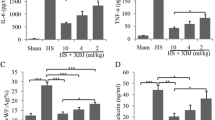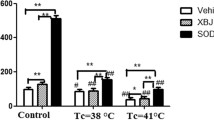Abstract
Objective
Systemic inflammatory mediators, including the high mobility group box 1 (HMGB1) protein, play important roles in the development of various inflammatory conditions. Although anticoagulants, such as antithrombin III (AT III), inhibit inflammation resulting from various causes, their anti-inflammatory mechanism of action is not well understood. Nevertheless, as heat stroke is a severe inflammatory response disease, we hypothesized that AT III would inhibit inflammation and prevent heat stress-induced acute heat stroke.
Methods
Male Wistar rats received a bolus injection of saline or 250 U of AT III per kg of body weight into the tail vein, followed by heat stress (exposure to 42°C for 30 min). Levels of cytokines (interleukin-1 β, interleukin-6, and TNF-α), NOx, and HMGB1 were measured in serum and tissue at regular intervals for 6 h after the heat stress induction.
Results
Levels of cytokines, NOx, and HMGB1 in serum decreased over time in AT III-treated rats. AT III pretreatment also reduced NOx levels during heat stress-induced inflammation. As a result, AT III pretreatment improved survival in a rat model of heat stress-induced acute inflammation.
Conclusions
Our data suggest that AT III pretreatment inhibited the secretion of cytokines, NOx, and HMGB1, and prevented heat stress-induced acute inflammation.








Similar content being viewed by others
References
Grogan H, Hopkins PM. Heat stroke: implications for critical care and anaesthesia. Br J Anaesth. 2002;88(5):700–7.
Bouchama A, Knochel JP. Heat stroke. N Engl J Med. 2002;346:1978–88.
Simon HB. Hyperthermia. N Engl J Med. 1993;329:483–7.
Lee JJ, Lin MT, Wang NL, Lin CL, Chang CK. Platonin, a cyanine photosensitizing dye, causes attenuation of circulatory shock, hypercoagulable state, and tissue ischemia during heat stroke. Shock. 2005;24:577–82.
Lu KC, Wang JY, Lin SH, Chu P, Lin YF. Role of circulating cytokines and chemokines in exertional heatstroke. Crit Care Med. 2004;32:399–403.
Bouchama A, Knochel JP. Heat stroke. N Engl J Med. 2002;346:1978–88.
Moncada S, Randomashi NW, Palmer RMJ. Endothelium-derived relaxing factor: identification as nitric oxide and role in control of vascular tone and platelet function. Biochem Pharmacol. 1988;37:2495–501.
Alzeer AH, Al-Arifi A, Warsy AS, Ansari Z, Zhang H, Vincent JL. Nitric oxide production is enhanced in patients with heat stroke. Intensive Care Med. 1999;25:58–62.
Bustin M. Regulation of DNA-dependent activities by the functional motifs of the high-mobility-group chromosomal proteins. Mol Cell Biol. 1999;19:5237–46.
Wang H, Bloom O, Zhang M, Vishnubhakat JM, Ombrellino M, Che J, et al. HMG-1 as a late mediator of endotoxin lethality in mice. Science. 1999;285:248–51.
Levy RM, Mollen KP, Prince JM, Kaczorowski DJ, Vallabhaneni R, Liu S, et al. Systemic inflammation and remote organ injury following trauma require HMGB1. Am J Physiol Regul Integr Comp Physiol. 2007;293:R1538–44.
Tsung A, Hoffman RA, Izuishi K, Critchlow ND, Nakao A, Chan MH, et al. Hepatic ischemia/reperfusion injury involves functional TLR4 signaling in nonparenchymal cells. J Immunol. 2005;175:7661–8.
Opal SM, Kessler CM, Roemisch J, Knaub S. Antithrombin, heparin, and heparan sulfate. Crit Care Med. 2002;30:S325–31.
Taylor FB Jr, Emerson TE Jr, Jordan R, Chang AK, Blick KE. Antithrombin-III prevents the lethal effects of Escherichia coli infusion in baboons. Circ Shock. 1988;26:227–35.
Wiedermann CJ. Clinical review: molecular mechanisms underlying the role of antithrombin in sepsis. Crit Care. 2006;10:209.
Hagiwara S, Iwasaka H, Matsumoto S, Noguchi T. High dose antithrombin III inhibits HMGB1 and improves endotoxin-induced acute lung injury in rats. Intensive Care Med. 2008;34:361–7.
Murakami K, McGuire R, Cox RA, Jodoin JM, Bjertnaes LJ, Katahira J, et al. Heparin nebulization attenuates acute lung injury in sepsis following smoke inhalation in sheep. Shock. 2002;18:236–41.
Heijnen BH, Straatsburg IH, Gouma DJ, Van Gulik TM. Decrease in core liver temperature with 10°C by in situ hypothermic perfusion under total hepatic vascular exclusion reduces liver ischemia and reperfusion injury during partial hepatectomy in pigs. Surgery. 2003;134:806–17.
Chiu CJ, McArdle AH, Brown R, Scott HJ, Gurd FN. Intestinal mucosal lesion in low-flow states: I, a morphological, hemodynamic, and metabolic reappraisal. Arch Surg. 1970;101:478–83.
Green LC, Wagner DA, Glogowski J, Skipper PL, Wishnok JS, Tannenbaum SR. Analysis of nitrate, nitrite and [15 N] nitrate in biological fluids. Anal Biochem. 1982;126:131–8.
Voll RE, Urbonaviciute V, Herrmann M, Kalden JR. High mobility group box 1 in the pathogenesis of inflammatory and autoimmune diseases. Isr Med Assoc J. 2008;10:26–8.
Mantell LL, Parrish WR, Ulloa L. Hmgb-1 as a therapeutic target for infectious and inflammatory disorders. Shock. 2006;25:4–11.
Lin XJ, Li YL, Mei GP, Zou F, He DD, Liu XQ, Li YJ, Zhao TB, Lin MT. Activated protein c can be used as a prophylactic as well as a therapeutic agent for heat stroke in rodents. Shock. 2009 Mar 13.
Wiedermann CJ, Hoffmann JN, Juers M, Ostermann H, Kienast J, Briegel J, et al. High-dose antithrombin III in the treatment of severe sepsis in patients with a high risk of death: efficacy and safety. Crit Care Med. 2006;34:285–92.
Dabrowski A, Gabryelewicz A. Nitric oxide contributes to multiorgan oxidative stress in acute pancreatitis. Scand J Gastroenterol. 1994;29:943–8.
Viola G, al-Mufti RA, Sohail M, Williamson RC, Mathie RT. Nitric oxide induction in a rat model of selective pancreatic ischemia and reperfusion. Hepatogastroenterology. 2000;47:1250–5.
Jiang W, Pisetsky DS. The role of IFN-alpha and nitric oxide in the release of HMGB1 by RAW 264.7 cells stimulated with polyinosinic-polycytidylic acid or lipopolysaccharide. J Immunol. 2006;177:3337–43.
Hall DM, Buettner GR, Matthes RD, Gisolfi CV. Hyperthermia stimulates nitric oxide formation: electron paramagnetic resonance detection of NO-heme in blood. J Appl Physiol. 1994;77:548–53.
al-Mashhadani SA, Gader AG, al Harthi SS, Kangav D, Shaheen FA, Bogus F. The coagulopathy of heatstroke: alterations in coagulation and fibrinolysis in heatstroke patients during the pilgrimage (Haj) to Makkah. Blood Coagul Fibrinolysis. 1994;5:731–6.
Bouchama A, Bridey F, Hammami MM, Lacombe C, al-Shail E, al-Ohali Y, et al. Activation of coagulation and fibrinolysis in heatstroke. Thromb Haemost. 1996;76:909–15.
Acknowledgments
The authors wish to thank Hiroaki Kawazato and Aiko Yasuda for helpful advice on hematoxylin and eosin staining.
Author information
Authors and Affiliations
Corresponding author
Additional information
Responsible Editor: L. Li.
Rights and permissions
About this article
Cite this article
Hagiwara, S., Iwasaka, H., Shingu, C. et al. High-dose antithrombin III prevents heat stroke by attenuating systemic inflammation in rats. Inflamm. Res. 59, 511–518 (2010). https://doi.org/10.1007/s00011-009-0155-y
Received:
Revised:
Accepted:
Published:
Issue Date:
DOI: https://doi.org/10.1007/s00011-009-0155-y




